As we shake off the holidays and kick off into a fresh new year, we at CloudSponge are reflecting on the events of 2013. As you know, a lot goes on in a year. Besides optimizing our website for smartphones and releasing free accounts for developers, we accomplished a lot of behind-the-scenes goals. But what’s the fun in it if we can’t share those with you? Ultimately, the more you know about what is going on at CloudSponge, the better you can use our software to your greatest benefit: which was the original goal, and is still our number one priority. Thus, we present, the CloudSponge “2013 Year in Review.”
Usage in 2013
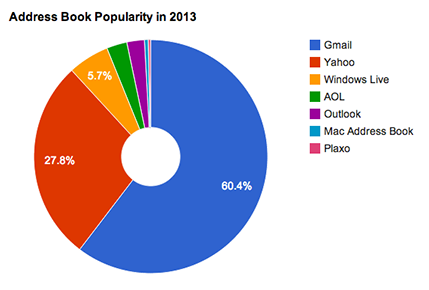
Is it cliché to say that “2013 was a big year”? Of course, everything feels more intense when autobiographical, so in that case: 2013 was a big year. For those of you who love big numbers – and we don’t mind them ourselves – we’ve got some vanity metrics to share: we transferred 52TB through our data center, imported 3.2 million address books, shared 924 million contact records and counted 13.7 million page views (not by hand).
For most people, the little black book is history. Now, everything is online. As some lament the loss of these traditional communication tools, let’s simultaneously look at the popularity of the address books on the market. Now forget about the black book. It was little. These are huge; which means, your reach can be huge as well.
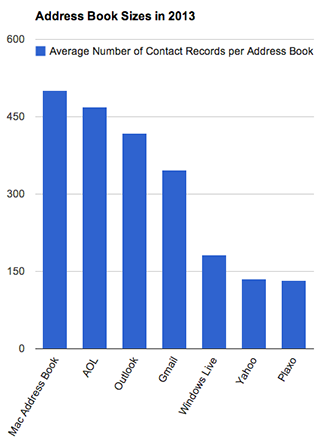
If you look at the graph to the left, there is one thing that stands out: address books are big enough to be significant referral tools. If you think about one of your customers, just one, having access to two to three hundred people on average, you are looking at an exponential reach of potential customers. Even more simply, this kind of reach is excellent for brand recognition, awareness and visibility. Sure, I’m pumping our tires, but it’s really just a numbers game.
Finally, we had downtime, yes, nobody’s perfect. But we were successful in tackling that downtime head on and mitigating issues in a turnaround time that’s worth talking about. How did we do it? It was as easy as putting good people in the right places, then watching them deliver on their goal of keeping the downtime hours lower than 0.5% of the entire year.

Product Changes
We shifted and grew in 2013, and the product reflected these changes. So what did we do?
We Got Responsive
It’s important that the website works and is easy to navigate on any device, and in 2013 we applied Bootstrap (mobile first front end framework) to the website. CloudSponge is now responsive on all tablets and smartphones, so that you don’t have to squint and zoom your way through the experience.
We Became the Masters of Our Domain(s)
We’ve worked with enough software development life cycles over the years to know that we probably don’t know yours, and that’s why we now offer the CloudSponge product free of charge to programmers working in development, staging or testing environments. While you’re cutting code, testing and – the fun part – breaking things, it’s important to us that you have the whole product so that you can build it into your site properly. Once it transitions from development to production, that’s when the money changes hands. Until then, code on, young developer. On us.
Previously, customers would pay $25/month for unlimited imports on as many domains as they wanted. If they ran three websites, they paid $25, even if they were all revenue-generating production environments. To be blunt, we realized that this was far from brilliant; we were undercharging them. One word: rebuild.
From the ground up, we restructured our pricing tiers. We released development only domains for free and we released domain-based pricing to align with their revenue sources. Therefore, the customer who has three different production domains would pay for each of them (better for us) and the customer with two development domains – for example, localhost and staging.myawesomewebsite.com – would pay $0 (better for them). No-brainer (that took us a couple years to figure out). We decided to offer free developer accounts for two major reasons. First, having developers email us every month asking to extend their free trial was aggravating. Secondly, there were cases of developers letting their free trial expire, then signing up for another account with a different email address. I mean, really? If that doesn’t call for a rethink, I don’t know what does.
We Integrated and Re-Integrated
Our integrations are the nucleus of our value proposition and we’re committed to making sure that they’re as good as it gets despite being in a constant state of change.
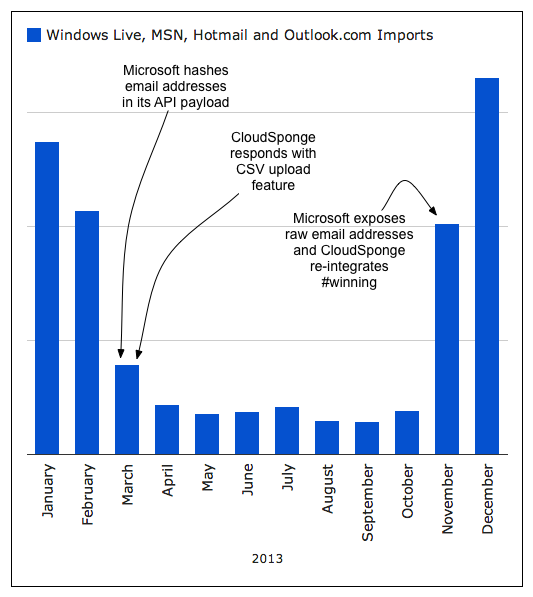
In our space, there is a debate surrounding the ownership of your address book, with the central question being: do you have the right to share your contacts? I think you do. Microsoft, on the other hand, has gone back and forth on it. What that has meant for our business and customers is that when Microsoft changed their policies and starting hashing email addresses on their Windows Live Contacts API, our customers’ users were no longer able to use it to share their Hotmail, MSN, Windows Live and Outlook.com email addresses. Non-ideally, we built a CSV import tool to bridge the gap until we could come up with something better. When Microsoft changed their minds again and quietly started exposing raw email addresses on their contacts API, we caught it. We re-integrated. Now our customers are reaping the benefits of us noticing the shifts at Microsoft. Responding and adapting; two of the reasons why we’re the best solution in the industry.
We also built automated 3rd party availability monitoring into our software (finally!). On 30-minute intervals, our monitor automatically checks that our integration with Yahoo, Gmail, Windows Live, AOL and Plaxo are working properly. We will admit that there was some procrastination in the accomplishment of this task, but the CloudSponge system now automagically keeps tabs on its ability to communicate with the third parties that we rely on. If you ever want to check on our ability to import from our webmail providers, just mozy on over to /contact-importers and see for yourself.
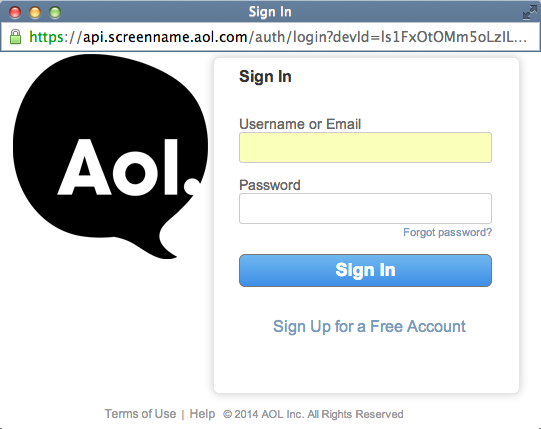
Further, we earned permission to use AOL’s OAuth2 API. Yes, you have to be special to get access to it, and yes, we have access to it. We’re clearly quite pleased with ourselves over this, as it means that our privacy-sensitive customers can rest assured that AOL usernames and passwords will never be shared with anyone except for AOL and its users.
This, for all intents and purposes, was meant to be a few paragraphs of humble bragging. But as I started writing, I realized how proud I am of the CloudSponge team for executing the adaptations and improvements we have in the last year. What do they say: don’t brag about yourself, let someone else do it for you? Well, every once in a while, you gotta break a few rules.
The Forecast for 2014
But First, The Mistakes
For us to move forward in 2014, we have to admit our mistakes from 2013. So, yes, we learned a few things last year, and sometimes, it takes a few times to learn something. For example, the decision to purchase advertising for CloudSponge could be compared to burning my mouth on food that is too hot. It’s the result of overzealous experimentation, during which I know deep down that I should refrain; this results in the outcome being equal parts painful and embarrassing. I’m not sure how many more proverbial bites I will have to take before I learn the lesson: ordinary online advertising like SEM and AdSense do not work for this product.
Retargeting via AdRoll, however, has been great for us and it has a very satisfying ROI. So this is really more an apology than anything; we’re sorry that after your initial visit to our site, we became inescapable in your online experience.
Pricing Changes
Before you fear the worst, our existing customers will not be forced to pay more, nor are we unreasonably jacking prices. We’re going to grandfather existing pricing plans because it wouldn’t be fair to charge more for the features our customers are already using. This year, we’ll release new pricing tiers that will charge fair prices for premium features such a rebranding and API access. Our latest ideas are heavily inspired by a blog post by Lincoln Murphy and we’ll be doing some much needed customer development along the way to make sure we get it right the first time. If you have an opinion and a minute, I’d love to hear from you.
Integrating Event Based Analytics
A few months ago, I admitted to one of my colleagues that I’ve been procrastinating on integrating event based analytics into CloudSponge. He was dumbfounded by the four years that we’ve spent acting on our gut instincts, or as he put it, “the luckiest guts in the world.”
Maybe we are lucky, because things up until this year have worked with decisions made on instinct and common sense. But, moving forward, we are sinking the analytics deep into the product. It’s the responsible thing to do. Having the option to measure events and make changes based on those events is going to save everybody time, money, stress – all of those things that entrepreneurs seem to always have too much or too little of. So, we are finally going to get around to integrating proper analytics. This is an internal move, and one that is going to allow us to take an in depth look at things like how people are engaging with the product, where we’re failing, and how we need to improve it. Essentially, it will allow us to understand the product in a real, quantifiable way – not just based on feeling – and as a result, endeavour to better figure out how to effectively attract and retain more customers. We plan on telling the story – from wins to losses – of this integration on our blog, so that you can learn from our experience.
After searching a couple dozen keywords, reading a few hours of blog posts, and perusing a ton of Quora threads, it became obvious that the world of event based analytics for B2B SaaS has been reduced to KISSmetrics and Mixpanel (for now). Despite more searches and a week’s worth of reading documents, taking demos and watching videos, the choice between them was still unclear.
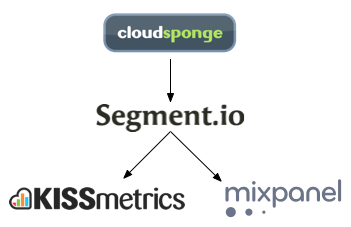
Fortunately, we came across a wicked blog post from Sacha Greif that mentioned Segment.io, an analytics tool that would let us do a single integration but allow a side-by-side test of the two platforms. That sounded like just what the doctor ordered, so integrating with Segment.io has quickly risen to the top of our priorities in our Github Issues.
As we travel down this road of data-driven decision making and vendor selection between all of the above, we’ll certainly do our best to share our experiences with you in hopes that you can avoid some pitfalls and get to the starting line faster if you’re trying to make the same decision.
Influences and Blogs
Without a doubt, David Skok is like the VC/advisor/mentor I never had. Every time that I read one of his blog posts and the subsequent comments, I learn something. In fact, they are some of the most intelligent online discussions I have had the good fortune to read. From this information platform, combined with Lincoln Murphy’s blog, GrowthHacker.tv’s interviews and the incredible transparency of Alex Turnbull over at Groove, I would say that I have benefitted from some of the best literature on operating a B2B SaaS business. These blogs are chockerblock pure gold; on topics from decreasing churn and building appropriate pricing tiers, to testing landing pages and accessing new marketing channels, as well as a whole gamut of topics that are relevant to our business model. But best of all, these blogs are effective in communicating clear skills, knowledge and specific experience that is applicable. With the learning curve being what it has been, there are few things that I appreciate more than good old honesty.
This is why I intend to put out a blog that is full of awesome, helpful content related to our own experience. With a blog, we can disseminate helpful information from the CloudSponge story to both existing and future customers. I have greatly benefitted from the information in blogs, and I want to pay it forward by doing the same for others. In theory, the CloudSponge blog is a go-to online destination for product-related content, as well as a platform for experiential updates and (hopefully, helpful) stories from our start-up experience. Further, when we make changes and improvements; you will know. When we make mistakes and fail; we’ll probably tell you about that too 😉 We want to communicate and engage with you, tackle your queries and augment your overall experience with our software. Then we want to tell the world all about it in our blog.
All in all, we are a startup; at which decent people work to accomplish decent things. We’ve built software that fits in as a missing piece of a larger puzzle, and we want to continue to improve and grow with a basic goal: to maximize your business’ reach and help you grow faster.
If you have gotten this far and have yet to try CloudSponge, it’s only reasonable that I present the link to test drive it.
Here’s to 2014,
P.S. Now, for the shameless request. We need our readers and customers to spread the CloudSponge word. Whether through Facebook, Twitter, Google Plus or LinkedIn, we aren’t begging, but are politely asking you to let others know if you’re happy with the product. We’re always game for cross-sharing and symbiotic promotion, so feel free to get in touch with us to hit the world wide web with a dual referral.
